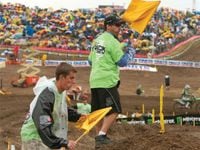Glory, it seems, is in extremely short supply in motocross. Normally reserved for winners and heroes, most racers will only attain brief glimpses of glory. Weekend warriors receive less still, and casual riders will only find glory, in its purest forms, once or twice. But without a doubt, the rock-bottom, lowest of the low, least glorious position in all of motocross has to be that of the flagger. Sunday after Sunday, moto after moto, the flagperson is required to stand at attention through rain and shine, dust and mud, cold and heat, all for the express purpose of providing a touch of safety to an anonymous racer. At the end of the day, when all is said and done, no one bothers to ask for an autograph, hand out a trophy or even say thanks to the flagger. This underappreciated job-if, considering the pay is little to none, you can even call it that-is executed with the knowledge that no praise or fame will ever result from the long day of efforts. And this is precisely what makes flagging so cool.As part one of Dirt Rider's new Day in the Life series, I quickly volunteered to hop into the trenches and try my hand as a motocross flagger. In all my days of racing, I have been held at the mercy of many a yellow flag but have ironically never even held one of my own. With plans to attend amateur day at the upcoming Hangtown Classic, I set things up with the Dirt Diggers North motorcycle club to volunteer as an event flagger. They were stoked to have an extra set of hands lined up to work, and I was pumped on the simple idea of watching the races from the track!For some reason, flaggers are famously given the short end of the stick. The most common flagmen photo is that of a young kid fast asleep in his chair or perhaps the one with an old man picking his nose while a rider cartwheels by. Almost all flaggers are usually portrayed as lazy, unaware, disheveled rednecks. Au contraire. From my weekend of working at the Hangtown track in Prairie City, I quickly realized the stereotypes of flaggers are ill-deserved and uncalled for.Upon arrival, I signed and picked up my official bright green flagger T-shirt, wristband and extra tickets. Flaggers at Hangtown aren't paid for their efforts, but they do receive a handful of tickets for friends and family to the event, as well as meal tickets to a few club-hosted barbecues. Sweet! Once I was signed in, I made my way over to the starting area, where Dirt Diggers club member and flagging coordinator Mike Mars was holding a meeting for all the flagmen and flagwomen who would be working the weekend.A solid rider and a skilled flagger himself, Mars went over a strict set of guidelines that all flaggers should adhere to, putting special emphasis on the point that a flagger should never have his or her back to any approaching rider. In addition to this, flaggers must remain off the track unless there is a rider down, in which case they should move up the track from the crash. In any event, if the yellow flag is being displayed, then the next two flaggers up the track from the incident must present their flags (but not wave them) in order to warn upcoming riders. Mars reiterated this last point, as it is incredibly helpful in smoothly getting riders around a problem area.Contrary to popular opinion, a flagger does not merely stick his yellow flag out onto the track and hold it there. Mars advises his workers to wave the flag if a rider is stopped on his bike and to wave in doubletime if the rider is actually down. For bikes on the side of the track, the flagger should hold up the flag with both hands to protect the rider. Mars also tells his crew that they should never sit down during the race and that they should be on their feet and attentive, looking both up and down the track. He further reminds them to stay hydrated, wear sunblock, keep rain gear close at hand and take full advantage of breaks when they are presented. Part of a flagger's job is to make sure the course is watered to perfection; Mars instructs his workers on how to water-and not overwater-a section. At the conclusion of the meeting, Mars hands out flags and gives each of the 39 workers their predetermined position on a numbered map, and we all head off for the first round of practice.As irony would have it, the first wave of my flag went to fellow freestyle rider Brian Deegan, whose racing comeback had temporarily left him cross-rutted on the landing of a large jump. With plenty of flaggers waving and Deegan hopping around on a wounded knee, I ran over and picked up the Mulisha General's bike-an act that we didn't learn how to handle during the flagger's meeting. After handing the bike off to Deegan, I headed over to a veteran flagger to clarify the procedures on downed bikes. "You did the right thing," remarked the flagger. "In the event that a bike is down on the course, you simply go when it is safe, and move it off to the side." Funny, but this flagger didn't seem like a disheveled redneck. I remarked this to him, to which he laughed. "Yeah, I am just a big fan. I do this every year, and it is a great way to help out and get in for free. I miss a lot of the good racing because I am busy with my section, but I know the riders appreciate it."And they certainly do. Over the next few hours, we flagged for quite a few racers who went down in our section, and nearly all were able to continue within a few quick moments. One thing I quickly learned is that flagging is more than just sitting and watching-you have to stay alert. Keeping one eye up the track and one eye down the track was a chore in itself, not to mention the amount of energy that goes into simply not getting hit.Being the rookie flagger of the group, Mars didn't assign me to a particular spot, but rather he had me float around and help as needed. During a track prep break between motos, I was able to walk around and talk to some of the other workers in the crew, who comprised of some of the most genuine people at the races. In addition to Dirt Diggers members, the local Polka Dot MC was in attendance to help out, as were several people who simply came to lend a hand and enjoy the races. A lot of the folks have been flagging at Hangtown for more than 15 years! The flag crew was super-diverse as well, with young kids, old men, married couples, racers and hard-core fans all doing their jobs with pride.Once practice and qualifying ended, we were ready to start flagging the big show, beginning with the first 125 (not Lites!) moto. But as the national anthem was playing, the sky opened up with a hefty spring rainstorm. Heading to one of the downhill doubles on the course, I had a bad feeling that I might have to use my flag. And I was right. Once the moto started, riders were sliding out and tipping over a lot more than they would have liked, but we were able to hop out onto the track and control the traffic. One tip that some of the other flaggers told me is to make eye contact with the rider as he approaches your waving flag, because this tells you that he acknowledges the incident. I did this, and the experienced pro racers (notably the oft-booed Mike Alessi, who led both motos) were all super-careful around the caution areas.As the day wore on and the mud kept flying, I had ample opportunities to learn the ropes of flagging, and believe me, it is not as easy as it looks. By the time the second motos rolled around, I thought I had seen it all, but an incident in the Lites moto really caught my eye. On one of the slick-faced jumps on the big downhill, Kelly Smith slid out up the face and went down hard. As he was getting back to his feet and grabbing his bike, a nearby flagger ran over to help, knowing that the area was already protected by my and another's waving flags. With the exhausted Smith trying to relight his four-stroke, the flagger shouted a few words of encouragement and gave the bike a huge push on the rear fender, allowing Smith to bump-start and continue, but not until after giving the poor flagman an unintentional face full of mud. With Smith on his way, the flagger darted onto the track and retrieved Smith's goggles, which he had forsaken after the fall. What happened next amazed me: The flagger took the muddy goggles, walked over to the spectator fence, past a pack of screaming drunks, and handed the goggles to a grinning kid. He then spun around, trotted back to his position, grabbed his flag and continued to stand at attention, soaking wet under his trash-bag-turned-poncho, with a look of sober contentment on his face.I'll be damned if that wasn't the most glorious thing I've seen in a while. Be a flagger some day. It's for real.
Latest

/cloudfront-us-east-1.images.arcpublishing.com/octane/3GXGR3EKSNH5NI3CWHV5SJ7TXE.jpg)
/cloudfront-us-east-1.images.arcpublishing.com/octane/JEU3ONDWEFCAZNAZJOU24OJ2PM.jpg)
/cloudfront-us-east-1.images.arcpublishing.com/octane/JQ6LMK6LLBAQJIL2AH56UIUKWU.jpg)
/cloudfront-us-east-1.images.arcpublishing.com/octane/QUSF4LLRM5DDPCJW25RINQRJPE.jpg)
/cloudfront-us-east-1.images.arcpublishing.com/octane/FYDGK7GF4JBPXERA5RAZPY3YJI.jpg)
/cloudfront-us-east-1.images.arcpublishing.com/octane/JE7KMNASNRGR7FLYAFRZAR7T7E.jpg)
/cloudfront-us-east-1.images.arcpublishing.com/octane/7RCNKJJNXBF4LBKZXE2INNWZUY.jpg)
/cloudfront-us-east-1.images.arcpublishing.com/octane/BAGM5E4EWBHFNLZOXMSLOLKQGU.jpg)
/cloudfront-us-east-1.images.arcpublishing.com/octane/RSX65VBXY5FRLIY4LN6WLOKAFM.jpg)
/cloudfront-us-east-1.images.arcpublishing.com/octane/3EO2CNKWUFBGNMGNJPETW5HCNY.jpg)
/cloudfront-us-east-1.images.arcpublishing.com/octane/IYHM55XRNVHF3DSS3467PZ7ONQ.jpg)
/cloudfront-us-east-1.images.arcpublishing.com/octane/L7K3FIINEBHMZI2TXTUE4FXH7I.jpg)
/cloudfront-us-east-1.images.arcpublishing.com/octane/XE7P5YXNZZDUTIGW4YNWQRDVY4.jpg)
/cloudfront-us-east-1.images.arcpublishing.com/octane/AV55DOHQ3BEXJLPWR6UWLYUSAQ.jpg)
/cloudfront-us-east-1.images.arcpublishing.com/octane/MMROGOYHXZAYDC4RKIDJ4VRSGA.jpg)
/cloudfront-us-east-1.images.arcpublishing.com/octane/FHRWLPEOTBFOHFTQLIHJNIXCFQ.jpg)
/cloudfront-us-east-1.images.arcpublishing.com/octane/J2RUDOXTOZHBXOFCUQKBAGBMAQ.jpg)
/cloudfront-us-east-1.images.arcpublishing.com/octane/UDQASRGJ3ZDG3BANXWU6P5NIQY.jpg)
/cloudfront-us-east-1.images.arcpublishing.com/octane/YIICVWCT7FDURLJQ2H4AIMXLOY.jpg)
/cloudfront-us-east-1.images.arcpublishing.com/octane/SKYGGQY3XJCPDAM4CUHUXBS444.jpg)
/cloudfront-us-east-1.images.arcpublishing.com/octane/AONOEIBHJBGMBOCD5HBWVB3UAI.jpg)
/cloudfront-us-east-1.images.arcpublishing.com/octane/76O4I66VBNBS5GXX4DNHXXKHR4.jpg)
/cloudfront-us-east-1.images.arcpublishing.com/octane/3LSXOLSH3NEJDBMO3JZ6CYMK5M.jpg)
